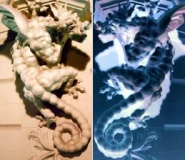Speaker
Dr
Mari Carmen Banuls
(Max-Planck-Institute for Quantum Optics)
Description
The characterization of entanglement is a fundamental issue for
Quantum Information Theory. But the definition of entanglement depends
on the notion of locality, and thus on the tensor product structure of
the state space of the composite system. This notion is affected by
the presence of superselection rules that restrict the accessible
Hilbert space to a direct sum of subspaces.
Indistinguishability of particles imposes one such restriction, namely
to totally symmetric or totally antisymmetric states. The
entanglement can in this case be defined with respect to partitions of
modes in the second quantization formalism. For fermionic systems the
Fock space of m modes is isomorphic to the space of m qubits, but the
action of creation and annihilation operators is not local, due to
their anticommutation.
Conservation of the parity of fermion number imposes another relevant
superselection rule. It requires that local physical observables
commute with the local parity operator.
Taking into account the considerations above, it is possible to define
the set of separable states or equivalently the concept of
entanglement for fermionic systems in a number of ways. We study such
possibilities, the relationship between different sets and their
possible characterization.
Author
Dr
Mari Carmen Banuls
(Max-Planck-Institute for Quantum Optics)
Co-authors
Prof.
J. Ignacio Cirac
(Max-Planck-Institute for Quantum Optics)
Prof.
Michael M. Wolf
(Niels Bohr Institute)
